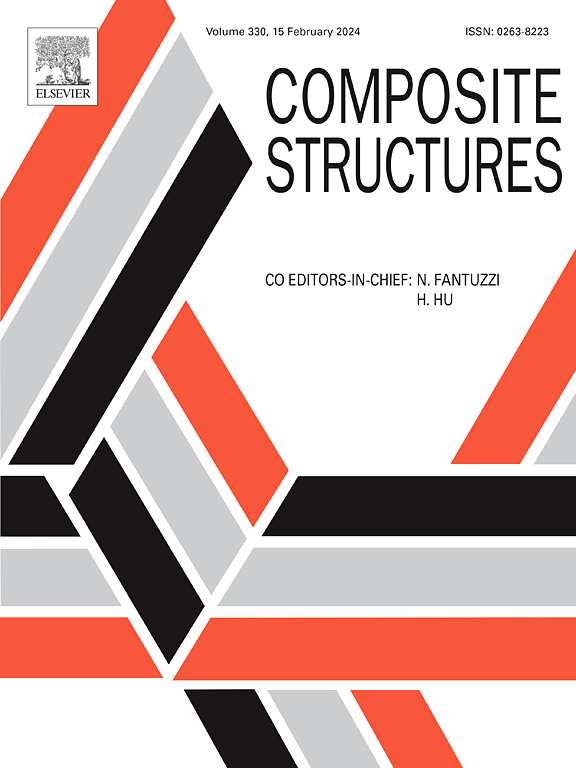Active vibration control of a curved sandwich beam using a nonlinear PPF algorithm
IF 6.3
2区 材料科学
Q1 MATERIALS SCIENCE, COMPOSITES
引用次数: 0
Abstract
Nonlinear behaviour resulting from large-amplitude vibrations is often categorized as softening or hardening, according to the direction of the shift in the natural frequency. While nonlinear hardening systems have been controlled in the past, often using positive position feedback (PPF) and both linear and nonlinear algorithms, softening systems have often been overlooked. In this experimental study, a curved sandwich beam with clamped boundary conditions when subject to large external forcing was subjected to various active vibration controllers based on linear and nonlinear PPF algorithms. The curved beam is a softening system presenting both quadratic and cubic stiffness terms. Piezoelectric patches were used as controller transducers. Both linear and nonlinear controller types were tested, with nonlinear controllers including both quadratic and cubic gain terms. Furthermore, single-input single-output (SISO) and multi-input multi-output (MIMO) architectures were both tested, with SISO controllers including only a single actuator and sensor pair and MIMO controllers involving two actuators and two sensors. While increasing the amplitude of the nonlinear terms in the not-optimized controller was found to significantly improve vibration attenuation, the optimized controller showed a smaller improvement following the introduction of nonlinear terms in its algorithm.
基于非线性PPF算法的弯曲夹层梁振动主动控制
根据固有频率移动的方向,由大振幅振动引起的非线性行为通常被分类为软化或硬化。虽然非线性硬化系统在过去已经被控制,通常使用正位置反馈(PPF)和线性和非线性算法,但软化系统经常被忽视。在实验研究中,采用基于线性和非线性PPF算法的各种主动振动控制器,对受大外力作用时具有夹紧边界条件的弯曲夹层梁进行了振动控制。曲线梁是一种兼具二次和三次刚度项的软化系统。采用压电片作为控制换能器。测试了线性和非线性控制器类型,非线性控制器包括二次和三次增益项。此外,我们还测试了单输入单输出(SISO)和多输入多输出(MIMO)架构,其中SISO控制器仅包含单个执行器和传感器对,而MIMO控制器包含两个执行器和两个传感器。在非优化控制器中,增加非线性项的幅值可以显著改善振动衰减,而在算法中引入非线性项后,优化控制器的改善幅度较小。
本文章由计算机程序翻译,如有差异,请以英文原文为准。
求助全文
约1分钟内获得全文
求助全文
来源期刊

Composite Structures
工程技术-材料科学:复合
CiteScore
12.00
自引率
12.70%
发文量
1246
审稿时长
78 days
期刊介绍:
The past few decades have seen outstanding advances in the use of composite materials in structural applications. There can be little doubt that, within engineering circles, composites have revolutionised traditional design concepts and made possible an unparalleled range of new and exciting possibilities as viable materials for construction. Composite Structures, an International Journal, disseminates knowledge between users, manufacturers, designers and researchers involved in structures or structural components manufactured using composite materials.
The journal publishes papers which contribute to knowledge in the use of composite materials in engineering structures. Papers deal with design, research and development studies, experimental investigations, theoretical analysis and fabrication techniques relevant to the application of composites in load-bearing components for assemblies, ranging from individual components such as plates and shells to complete composite structures.
 求助内容:
求助内容: 应助结果提醒方式:
应助结果提醒方式:


